IEEE/ACM SC97
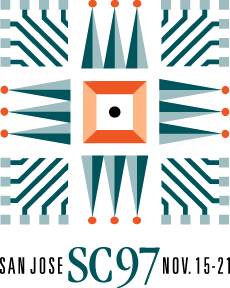
IEEE/ACM SC97
For the tenth Supercomputing sponsored by ACM SIGARCH and the IEEE Computer Society, the conference changed its official title to SC97: High Performance Networking and Computing. The change generally reflects the fact that networking and distributed computing have become so important to supercomputing... and there was a heavier emphasis on networking than there had been at previous Supercomputing conferences. This was effectively "the year of the cluster"; the year that everybody started taking cluster computing seriously.
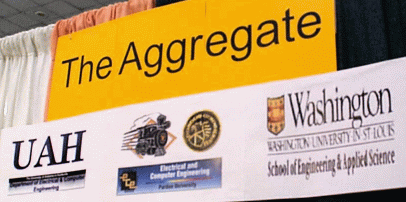
We also underwent a name change of sorts. Given the number of universities using PAPERS/AFAPI, it didn't seem right to call the exhibit the Purdue University booth. Instead, the exhibit was labeled "The Aggregate" -- a collection of PAPERS/AFAPI users/developers clearly centered at Purdue, but no longer contained within Purdue. Both the University of Alabama at Huntsville and Washington University in St. Louis were explicitly represented in the booth.
The exhibits were in the San Jose, California, convention center, November 17-20, 1997. That's a long way from Purdue... too long for us to carry much. We had a full 20'x20' exhibit, largely thanks to Hewlett Packard (HP).
HP offered us the free loan of HP workstations for the conference...
so, we called and asked for 17 systems, which they agreed to provide.
The bad news was that they couldn't spare 17 PCs. The machines we got
were HP B160L PA-RISC workstations running HP-UX... they are nice
machines, but they were totally unfamiliar. Two machines arrived at
Purdue two weeks before SC97, and one arrived at Washington two days
later, so that we could port our software and develop demonstrations.
Unfortunately, we quickly discovered that the mapping of the parallel
I/O ports into user space was prevented by a kernel security patch,
and that problem never got resolved. Instead, we accessed our hardware
using lseek(), write(), and
read() on /dev/kmem... a kludge that works,
but gives barrier times approaching 50 microseconds (20 times slower
than we get with user-space port access on Linux PCs). Of course, that
is still much faster than using a conventional network.
The 4 by 4 wall of 1,280 by 1,024 displays gave us a total resolution
of 5,120 by 4,096 pixels - easily the highest resolution display
ever presented at the Supercomputing conference. (It would be far
more impressive using an array of video projectors instead of monitors,
but monitors are what we had.) Using code taken from
xlockmore (an X screen saver) to grab the full display of
each machine, we ran four demos on this wall:
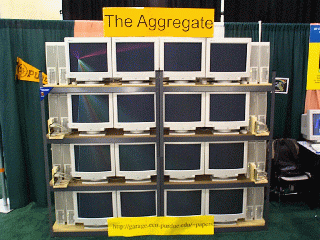 A simple program
that randomly selects a point on the wall and sends multi-color lines
out from it. To ensure perfect coherence of the displays, an
A simple program
that randomly selects a point on the wall and sends multi-color lines
out from it. To ensure perfect coherence of the displays, an
XSync() and barrier synchronization across all machines
is performed for each line drawn. This code was based on the "laser"
screen saver.
 A floating-point
intensive 3D N-body simulation of galaxies colliding. This demo is
also based on a screen saver, "galaxy," but it was heavily modified to
produce more realistic effects. For example, stars get larger as they
get nearer.
A floating-point
intensive 3D N-body simulation of galaxies colliding. This demo is
also based on a screen saver, "galaxy," but it was heavily modified to
produce more realistic effects. For example, stars get larger as they
get nearer.
 A high-resolution
GIF of the area around the Mars lander was resolution doubled and then
smoothly scrolled back and forth across the displays. Actually, two
separate images were used; one for the top 8 displays, the other for
the bottom 8. The scrolling images were each 2,048 by about 18,000
pixels.
A high-resolution
GIF of the area around the Mars lander was resolution doubled and then
smoothly scrolled back and forth across the displays. Actually, two
separate images were used; one for the top 8 displays, the other for
the bottom 8. The scrolling images were each 2,048 by about 18,000
pixels.
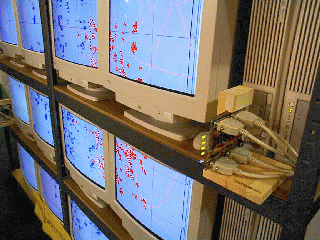 In another
exhibit, a battlefield simulation was being coordinated across
multiple supercomputers at various sites. On the last day of the
exhibits, we managed to get a feed of 1,280 by 1,024 GIF images from
that simulation scaled and displayed across our wall.
In another
exhibit, a battlefield simulation was being coordinated across
multiple supercomputers at various sites. On the last day of the
exhibits, we managed to get a feed of 1,280 by 1,024 GIF images from
that simulation scaled and displayed across our wall.
Although we had various other goodies on display, the video wall definitely stole the show. Here are a few of the other things we demonstrated or released at SC97:
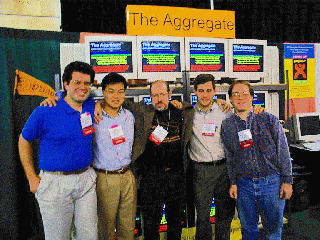
The photo above shows the Purdue people who staffed our booth. From left to right, Randy Fisher, Soohong Kim, Hank Dietz, Ray Hoare, and Tim Mattox. Hank Dietz is currently on sabbatical at Washington University, and thus also presented some work from that school. Will Cohen, from the University of Alabama at Huntsville, also participated in the exhibit, but had to leave early (before the photo was taken).
The next public demonstration of PAPERS at a conference was November 1998 at IEEE/ACM SC98.